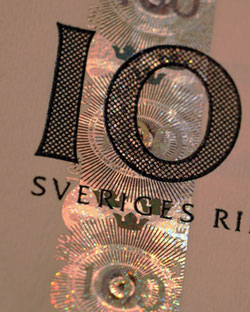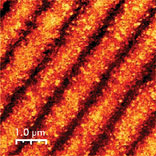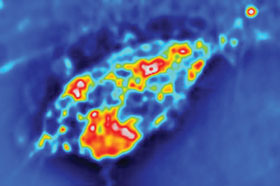 Typically, green, simple three-dimensional images of objects on flat paper are not unknown to today’s kids – or to anyone who has grown up during the past few decades. We encountered them first as wonderments – optical tricks that astounded and pleased the eye in the same way as flicker rings and early 3-D schlock movies. As playthings for kids, holographic pictures never exploded into the public conscience as lasers and telescopes did, but, more recently, holography has found several niches in which important work can be done.
Typically, green, simple three-dimensional images of objects on flat paper are not unknown to today’s kids – or to anyone who has grown up during the past few decades. We encountered them first as wonderments – optical tricks that astounded and pleased the eye in the same way as flicker rings and early 3-D schlock movies. As playthings for kids, holographic pictures never exploded into the public conscience as lasers and telescopes did, but, more recently, holography has found several niches in which important work can be done.
And a touch of silver nanoparticles
 To create a hologram, two beams of light are reflected off an object. This usually involves a pair of lasers or one laser and a beamsplitter. Interferometric differences caused by the first (illuminating) beam and the second (reference) beam record spatial information from the object onto a photographic plate. This information does not include just intensity, such as in photography, but also dimension. The twin-beam technique also can be used to form a special type of diffraction – or holographic – grating. Here, however, the interference fringes are imposed onto a photoresistive material. The resulting grating exhibits less light scattering than a standard one.
To create a hologram, two beams of light are reflected off an object. This usually involves a pair of lasers or one laser and a beamsplitter. Interferometric differences caused by the first (illuminating) beam and the second (reference) beam record spatial information from the object onto a photographic plate. This information does not include just intensity, such as in photography, but also dimension. The twin-beam technique also can be used to form a special type of diffraction – or holographic – grating. Here, however, the interference fringes are imposed onto a photoresistive material. The resulting grating exhibits less light scattering than a standard one.
At Université de Haute-Alsace in Mulhouse, France, Lavinia Balan and her colleagues are improving the process of recording holographic gratings by adding silver nanoparticles to the mix. In a one-pot technique, her group performed nanoparticle synthesis concurrently with photochemical preparation of a polyacrylic base. The silver particles, now imbued into the acrylic interference pattern, significantly enhance both the holographic and diffraction efficiency of the grating. The team reported its work in the Dec. 22, 2009, issue of Chemistry of Materials.
Even more unique
Although there is a lot of ongoing research into novel ways to explore holographic principles, most of the practical, day-to-day uses of holograms are in measures such as securing licenses, passports, credit cards and other portable accoutrements that often are the targets of identity thieves. There are a large number of companies that churn out holographic stickers for credit cards, ID badges and product labels at a commodities level. But some companies, such as JDSU Corp. in Milpitas, Calif., strive to improve the uniqueness of holograms to ensure secure identification of people and products.
The company recently updated its lines of hot-stamped foil products, security laminates, and pressure-sensitive labels and seals. It also has developed a process, dubbed HoloFuse, that addresses possible flaws in standard printed holographic products.
 Security mavens like holography for IDs and product packaging because no two holograms are ever alike, even if they are made with similar equipment imaging the same object. But even state-of-the-art materials, such as polycarbonate-coated cards, are made with a laminate process that imperfectly bonds the plastic to the hologram. The holograms used in clear-laminate cards also are prone to fading – from the lamination process on – and thieves can peel the layers of a legitimate ID apart and incorporate the hologram into a false document.
Security mavens like holography for IDs and product packaging because no two holograms are ever alike, even if they are made with similar equipment imaging the same object. But even state-of-the-art materials, such as polycarbonate-coated cards, are made with a laminate process that imperfectly bonds the plastic to the hologram. The holograms used in clear-laminate cards also are prone to fading – from the lamination process on – and thieves can peel the layers of a legitimate ID apart and incorporate the hologram into a false document.
JDSU’s HoloFuse material is a polycarbonate film that directly incorporates the holographic pattern into its surface. No adhesives are needed, and no fading is possible. There also are no layers of disparate materials to strip apart, leaving potential ID thieves adrift.
Holography has a certain “wow” factor to it that draws the public, especially children, to science museums and art exhibits. Most people don’t know the science behind the technique, but for some, one really cool hologram acts as a gateway to a lifelong interest in science.
Heard it through the cell grapevine
Understanding the cells that comprise our bodies ultimately will require that we find out how they communicate with each other. Whether they are neurons or blood cells, tumor cells or stem cells, they must “talk” to each other to accomplish their biological tasks. And if they talk to one another, Gabriel Popescu of the Beckman Institute for Advanced Science and Technology in Urbana, Ill., wants to listen in.
 Where normal cellular research comprises microscopy of fixed, dead cells, Popescu and his colleagues combine light-scattering, interferometry and microscopy to create videos of live cells in action.
Where normal cellular research comprises microscopy of fixed, dead cells, Popescu and his colleagues combine light-scattering, interferometry and microscopy to create videos of live cells in action.
“We are actually accurately measuring their motion at the nanoscale,” he said. “So that, in many ways, with all of these vibrations, [it] is very close to listening to something.”
Ultimately, Popescu wants to be able to talk back, but for now it’s about the process. Adding interferometric tools to a basic microscope setup did not provide mere images to look at; it provided the quantitative information that truly reveals the nanoscale structure of the cells.
“That is fairly unique. Commercial microscopes don’t do that,” he said. “In a way, this is combining holography with microscopy. It’s a new but very dynamic field that we are contributing to.”